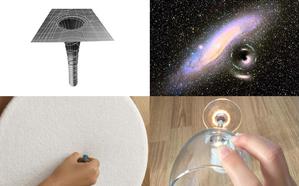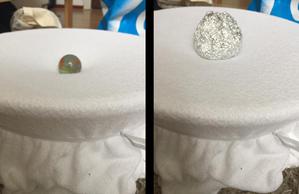Glossarbegriffe: Schwarzes Loch
Description: Ein Schwarzes Loch ist ein Bereich des Weltraums, in dem die Gravitationskraft so groß ist, dass nichts, nicht einmal Licht, aus ihm entkommen kann.
Viele Galaxien, darunter auch die Milchstraße, haben ein großes Schwarzes Loch (ein sogenanntes supermassereiches Schwarzes Loch) in ihrem Zentrum.
Astronomen vermuten, dass kleinere Schwarze Löcher unter anderem dadurch entstehen, dass ein massereicher Stern am Ende seines Lebens kollabiert. Wie supermassereiche Schwarze Löcher entstehen, ist aber nicht bekannt.
Die äußere Begrenzung eines Schwarzen Lochs wird als Ereignishorizont bezeichnet.
In der Nähe von Schwarzen Löchern sind die physikalischen Bedingungen so extrem, dass die Zeit viel langsamer abläuft im Vergleich zu einem Beobachter, der weit vom Schwarzen Loch entfernt ist. In der Nähe kleinerer Schwarzer Löcher werden Objekte auseinandergezogen und zerrissen. Materie, die auf ein Schwarzes Loch zufällt, bildet eine Akkretionsscheibe. Dies kann oft mit Materiestrahlen (sogenannten Jets) einhergehen, die von dieser Scheibe ausgehen. Akkretionsscheiben von Schwarzen Löchern sind die Energiequellen von Quasaren und anderen aktiven galaktischen Kernen (AGN) sowie vieler anderer Röntgenquellen.
Zugehörige Glossarbegriffe:
See this term in other languages
Term and definition status: The original definition of this term in English have been approved by a research astronomer and a teacher The translation of this term and its definition is still awaiting approval
The OAE Multilingual Glossary is a project of the IAU Office of Astronomy for Education (OAE) in collaboration with the IAU Office of Astronomy Outreach (OAO). The terms and definitions were chosen, written and reviewed by a collective effort from the OAE, the OAE Centers and Nodes, the OAE National Astronomy Education Coordinators (NAECs) and other volunteers. You can find a full list of credits here. All glossary terms and their definitions are released under a Creative Commons CC BY-4.0 license and should be credited to "IAU OAE".
If you notice a factual or translation error in this glossary term or definition then please get in touch.
Related Activities
Hunting for black holes
astroEDU educational activity (links to astroEDU website) Description: How do astronomers detect invisible black holes?
License: CC-BY-4.0 Creative Commons Namensnennung 4.0 International (CC BY 4.0) icons
Tags:
Model
, Experiment
Age Ranges:
12-14
Education Level:
Informal
, Middle School
Areas of Learning:
Modelling
, Observation based
, Problem-solving
, Social Research
Costs:
Low Cost
Duration:
45 mins
Group Size:
Group
Skills:
Constructing explanations
, Developing and using models
What is a black hole?
astroEDU educational activity (links to astroEDU website) Description: What are black holes and what would happen if the Sun was replaced by one of them?
License: CC-BY-4.0 Creative Commons Namensnennung 4.0 International (CC BY 4.0) icons
Tags:
Model
, Experiment
, Investigation
Age Ranges:
12-14
Education Level:
Informal
, Middle School
Areas of Learning:
Discussion Groups
, Interactive Lecture
, Modelling
, Observation based
, Problem-solving
, Social Research
Costs:
Low Cost
Duration:
45 mins
Group Size:
Group
Skills:
Constructing explanations
, Developing and using models
, Engaging in argument from evidence
, Planning and carrying out investigations
Model of a Black Hole
astroEDU educational activity (links to astroEDU website) Description: Understand the mystery of black holes through a hands-on activity.
License: CC-BY-4.0 Creative Commons Namensnennung 4.0 International (CC BY 4.0) icons
Tags:
Hands-on
, Model
, Interactive
, Space-time
, Black holes
Age Ranges:
8-10
, 10-12
Education Level:
Primary
, Secondary
Areas of Learning:
Modelling
, Social Research
Costs:
Medium Cost
Duration:
1 hour
Group Size:
Group
Skills:
Asking questions
, Developing and using models











